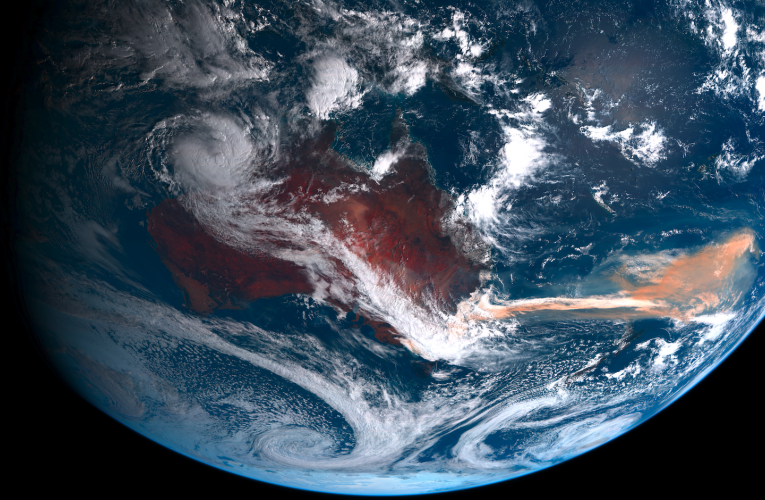According to an international team of researchers led by Duke University, the Australian wildfires of 2019 and 2020 caused clouds of smoke and ash that triggered extensive algal blooms in the Southern Ocean thousands of miles downwind to the east.
 A satellite image shows smoke from the 2019–2020 Australian wildfires covering parts of the Southern Ocean. Image Credit: Japan’s National Institute of Information and Communication Technology.
A satellite image shows smoke from the 2019–2020 Australian wildfires covering parts of the Southern Ocean. Image Credit: Japan’s National Institute of Information and Communication Technology.
The peer-reviewed study was published in Nature on September 15th, 2021, and is the first to decisively connect a large-scale reaction in oceanic life to fertilization by pyrogenic (or fire-made) iron aerosols from a wildfire.
When minute aerosol particles of iron found in the wind-blown smoke and ash fell into the water, the water was fertilized, thereby providing nutrients to trigger blooms at a scale unparalleled in that location.
New questions have been raised after this discovery about the role wildfires may play in stimulating the growth of tiny marine algae called phytoplankton that have the capacity to absorb large quantities of climate-warming carbon dioxide (CO2) from the atmosphere by way of photosynthesis and are the basis of the marine food web.
Our results provide strong evidence that pyrogenic iron from wildfires can fertilize the oceans, potentially leading to a significant increase in carbon uptake by phytoplankton.
Nicolas Cassar, Study Corresponding Author and Professor of Biogeochemistry, Nicholas School of the Environment, Duke University
The algal blooms stimulated by the Australian wildfires were so strong and widespread that the ensuing increase in photosynthesis may have momentarily compensated a significant fraction of the fires’ CO2 emissions, added Cassar.
However, it is still uncertain how much of the carbon absorbed by that incident, or by algal blooms activated by other wildfires, remains securely stored deep in the ocean and how much is emitted back into the air. Cassar explains that their next challenge would be to determine that.
Large wildfires, like the record-breaking fires that wrecked several areas of Australia between 2019 and 2020 and the intense fires currently destroying areas in the western United States, the Mediterranean Siberia, the Amazon and elsewhere, are estimated to happen more regularly due to climate change, observed Weiyi Tang, a postdoctoral fellow in geosciences at Princeton University.
Tang also co-led the study as a doctoral candidate in Cassar’s lab at Duke University.
These fires represent an unexpected and previously under-documented impact of climate change on the marine environment, with potential feedbacks on our global climate.
Weiyi Tang, Study Co-Lead and Postdoctoral Fellow in Geosciences, Princeton University
When trees, brush and other forms of biomass are burned, pyrogenic aerosols are created. Aerosol particles are light enough to be transported for months in a fire’s windborne smoke and ash, across great distances.
Although the new study concentrated on the impacts of wildfires in the Southern Ocean, other areas, such as the North Pacific and areas close to the equator where deeper, colder waters are found at the surface, “should also be responsive to iron additions from wildfire aerosols,” said Joan Llort.
Joan Llort is a postdoctoral fellow in marine biogeochemistry at the Barcelona Supercomputing Center, who co-led the study as a research fellow at the Institute of Marine and Antarctic Studies (University of Tasmania).
Cassar and Richard Matear of CSIRO, Australia’s national science agency, were corresponding authors of the study, which was carried out by scientists from the University of Tasmania, Duke, the Barcelona Supercomputing Center, the CSIRO Oceans and Atmosphere program and the Plymouth Marine Laboratory.
The researchers employed robotic ocean floats, satellite observations, atmospheric transport modeling and atmospheric chemistry measurements to monitor the dispersion of pyrogenic iron aerosols from the Australian wildfires and quantify their influences on marine productivity.
France’s “Laboratoire d’Excellence” LabexMER and Investissements d’Avenir programs, the Australian Research Council, a Harry H. Hess Postdoctoral Fellowship, the AXA Research Fund, the CSIRO Decadal Climate Forecasting Project and the European Union’s Horizon 2020 program financially supported this research.
Besides his faculty position at Duke, Cassar holds a research appointment at the Laboratoire des Sciences de l'Environnement Marin of the Institut Universitaire Européen de la Mer in Brest, France.
Journal Reference:
Tang, W., et al. (2021) Widespread phytoplankton blooms triggered by 2019–2020 Australian wildfires. Nature. doi.org/10.1038/s41586-021-03805-8.